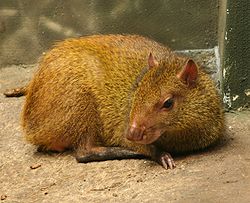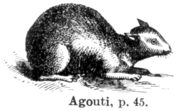
Common agouti
Background to the schools Wikipedia
This Wikipedia selection is available offline from SOS Children for distribution in the developing world. Click here for more information on SOS Children.
| Common Agoutis Temporal range: Recent |
|
|---|---|
 |
|
| Dasyprocta leporina | |
| Scientific classification | |
| Kingdom: | Animalia |
| Phylum: | Chordata |
| Class: | Mammalia |
| Order: | Rodentia |
| Family: | Dasyproctidae |
| Genus: | Dasyprocta Illiger, 1811 |
| Species | |
|
Dasyprocta azarae |
|
The popular term (common) agouti designates several rodent species of the genus Dasyprocta that inhabit areas of Central America, the West Indies and northern South America. They are related to guinea pigs and look quite similar, but with longer legs.
Confusingly, the related pacas were placed by some authorities in a genus called Agouti, though Cuniculus has priority and is the correct term (Woods and Kilpatrick, 2005).
Agoutis have five front and three hind toes; the first toe is very small. The tail is very short or non-existent. The molar teeth have cylindrical crowns, with several islands and a single lateral fold of enamel. Agoutis may grow to be up to 60 cm in length and 4 kg in weight. Most species have a brown back and a whitish or buffy belly; the fur may have a glossy appearance and then glimmers in an orange colour. They are active at day. In the wild they are shy animals and flee from humans, while in captivity they may become trusting.
When feeding, agoutis sit on their hind legs and hold food between their forepaws. They feed on fruit and other parts of plants. Sometimes they can cause damage to sugarcane and banana plantations. They are regarded as the only species that can open Brazil nuts, mainly thanks to their strength and exceptionally sharp teeth. (Note - Capuchin monkeys are recently reported to also eat them, after using a stone as an anvil.) Their habitat includes rainforests, savannas and, nowadays, cultivated fields, depending on the species. They conceal themselves at night in hollow tree-trunks, or in burrows among roots. Active and graceful in their movements, their pace is either a kind of trot or a series of springs following one another so rapidly as to look like a gallop. They take readily to water, in which they swim well.
Agoutis give birth to litters of two to four young. They can live for as long as twenty years, a remarkably long time for a rodent.
Species
- Azara's Agouti, Dasyprocta azarae
- Coiban Agouti, Dasyprocta coibae
- Crested Agouti, Dasyprocta cristata
- Black Agouti, Dasyprocta fuliginosa
- Orinoco Agouti, Dasyprocta guamara
- Kalinowski Agouti, Dasyprocta kalinowskii
- Brazilian Agouti, Dasyprocta leporina
- Mexican Agouti, Dasyprocta mexicana
- Black-rumped Agouti, Dasyprocta prymnolopha
- Central American Agouti, Dasyprocta punctata
- Ruatan Island Agouti, Dasyprocta ruatanica


